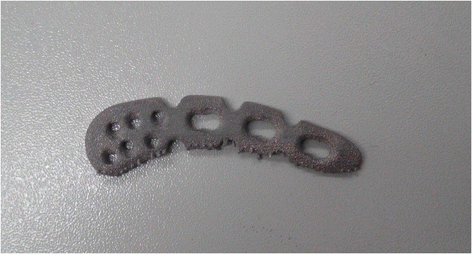A study on the mechanical characteristics of the EBM-printed Ti-6Al-4V LCP plates in vitro
- PMID: 25370215
- PMCID: PMC4221727
- DOI: 10.1186/s13018-014-0106-3
A study on the mechanical characteristics of the EBM-printed Ti-6Al-4V LCP plates in vitro
Abstract
Purpose: The electron beam melting (EBM) Ti-6Al-4V material technology has been developed over a short time period. It was introduced through a research to develop Ti-6Al-4V implants for patients, but EBM printed locking compression plates have not been used for clinical implants. The main purpose of this study is to find whether the EBM Ti-6Al-4V plate suit for clinical implants.
Methods: First, we scanned an AO-locking compression plate (LCP) and printed LCP samples using EBM. Next, we evaluated the EBM plate surface roughness through optical microscopy as well as the LCP and EBM plates' mechanical characteristics using the ASTM standard, which is commonly used to test the mechanical properties of bone plates subject to bending. Each sample was examined using a single-cycle four-point bending test and hardness testing to acquire data on bending stiffness, bending strength, bending structural stiffness, and hardness.
Results: The results show significant differences in bending stiffness, bending strength, bending structural stiffness, and hardness between the samples using EBM and the original LCP plates. The EBM-printed samples' surface roughness was 0.49 ± 0.02 μm. The mean hardness of the LCP sample was 266.67 HV10 ± 5.8, and the EBM-printed sample mean hardness was 341.1 HV10 ± 1.93. The EBM samples' bending stiffness was 87.67%, which is greater than using the LCP plates'; and the bending strength was 190.7% greater, the bending structural stiffness was 73.2% greater, and the hardness was 27.9% greater.
Conclusions: The results show that the EBM plates' general mechanical strength was significantly greater than the LCP plates. An EBM plate is advantageous for clinical implants because it can be customized with great potential for improvement.
Figures




Similar articles
-
An initial study of diffusion bonds between superplastic Ti-6Al-4V for implant dentistry applications.J Prosthet Dent. 2007 Jun;97(6):357-65. doi: 10.1016/S0022-3913(07)60024-9. J Prosthet Dent. 2007. PMID: 17618918
-
Properties of a porous Ti-6Al-4V implant with a low stiffness for biomedical application.Proc Inst Mech Eng H. 2009 Feb;223(2):173-8. doi: 10.1243/09544119JEIM466. Proc Inst Mech Eng H. 2009. PMID: 19278194
-
[A preliminary study on the mechanical characteristics of the titanium scaffolds with three-dimensional mesh structure fabricated by electron beam melting].Zhonghua Kou Qiang Yi Xue Za Zhi. 2016 Nov 9;51(11):656-660. doi: 10.3760/cma.j.issn.1002-0098.2016.11.004. Zhonghua Kou Qiang Yi Xue Za Zhi. 2016. PMID: 27806757 Chinese.
-
Metallic powder-bed based 3D printing of cellular scaffolds for orthopaedic implants: A state-of-the-art review on manufacturing, topological design, mechanical properties and biocompatibility.Mater Sci Eng C Mater Biol Appl. 2017 Jul 1;76:1328-1343. doi: 10.1016/j.msec.2017.02.094. Epub 2017 Feb 24. Mater Sci Eng C Mater Biol Appl. 2017. PMID: 28482501 Review.
-
Design and 3D-printing of titanium bone implants: brief review of approach and clinical cases.Biomed Eng Lett. 2018 Jul 12;8(4):337-344. doi: 10.1007/s13534-018-0080-5. eCollection 2018 Nov. Biomed Eng Lett. 2018. PMID: 30603218 Free PMC article. Review.
Cited by
-
Evaluation of the Properties of 3D-Printed Ti Alloy Plates: In Vivo and In Vitro Comparative Experimental Study.J Clin Med. 2023 Jan 5;12(2):444. doi: 10.3390/jcm12020444. J Clin Med. 2023. PMID: 36675373 Free PMC article.
-
3D printed personalized titanium plates improve clinical outcome in microwave ablation of bone tumors around the knee.Sci Rep. 2017 Aug 8;7(1):7626. doi: 10.1038/s41598-017-07243-3. Sci Rep. 2017. PMID: 28790331 Free PMC article.
-
Design considerations for patient-specific bone fixation plates: a literature review.Med Biol Eng Comput. 2023 Dec;61(12):3233-3252. doi: 10.1007/s11517-023-02900-4. Epub 2023 Sep 11. Med Biol Eng Comput. 2023. PMID: 37691047 Review.
-
Computer Navigation and 3D Printing in the Surgical Management of Bone Sarcoma.Cells. 2021 Jan 20;10(2):195. doi: 10.3390/cells10020195. Cells. 2021. PMID: 33498287 Free PMC article. Review.
-
Customized Knee Prosthesis in Treatment of Giant Cell Tumors of the Proximal Tibia: Application of 3-Dimensional Printing Technology in Surgical Design.Med Sci Monit. 2017 Apr 7;23:1691-1700. doi: 10.12659/msm.901436. Med Sci Monit. 2017. PMID: 28388595 Free PMC article.
References
-
- Zeman J, Matejka J, Matejka T, Salasek M, Zeman P, Nepras P. Open reduction and plate fixation (ORIF LCP) for treatment of bilateral calcaneal fractures. Acta Chir Orthop Traumatol Cech. 2013;80(2):142–147. - PubMed
Publication types
MeSH terms
Substances
LinkOut - more resources
Full Text Sources
Other Literature Sources

